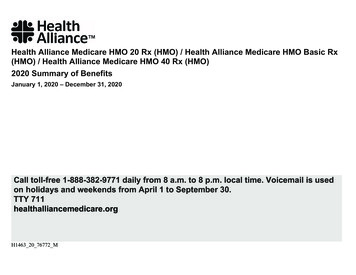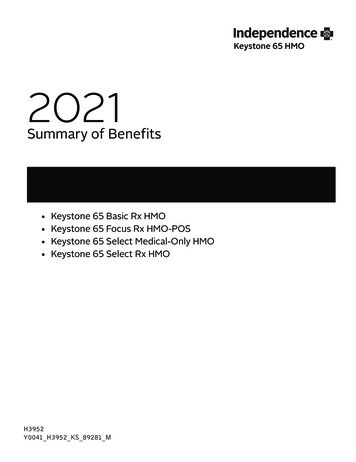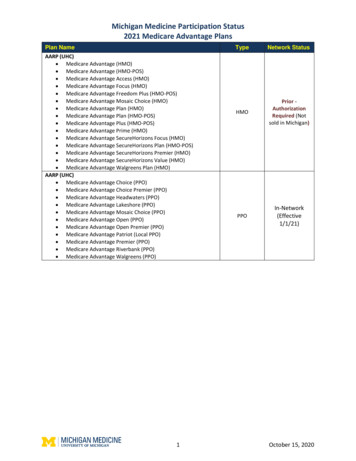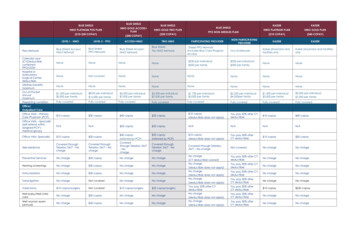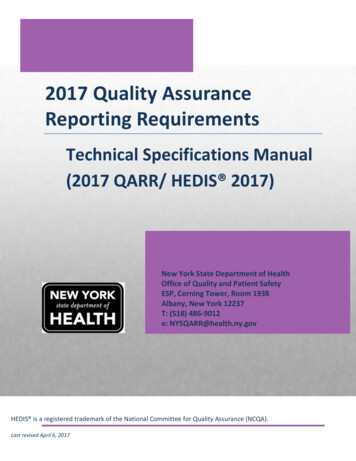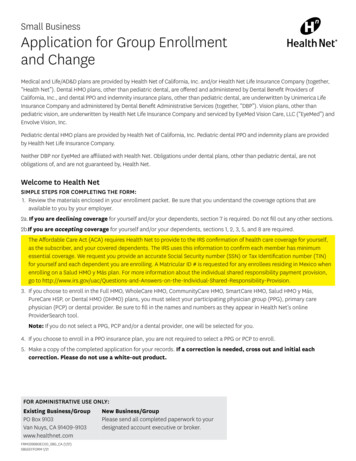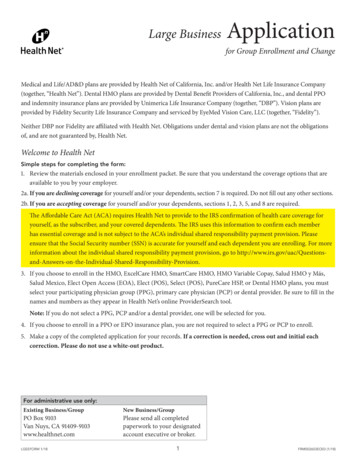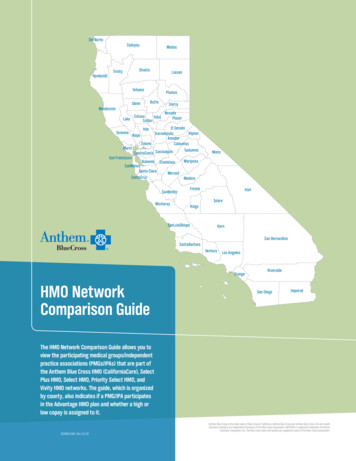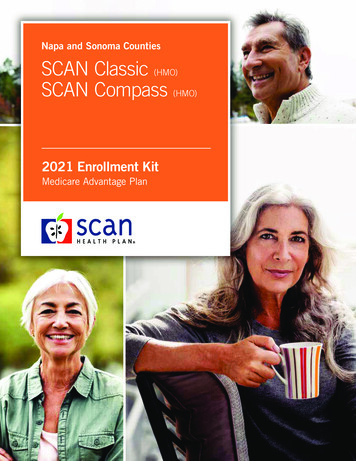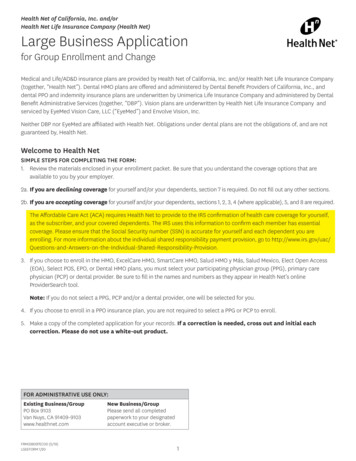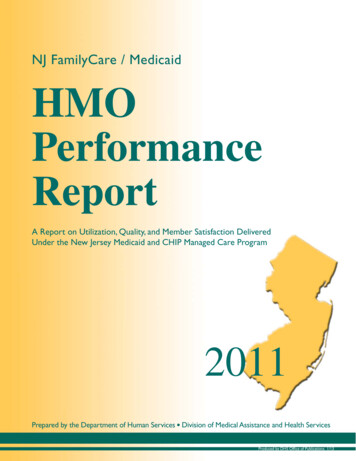
Transcription
NJ FamilyCare / MedicaidHMOPerformanceReportA Report on Utilization, Quality, and Member Satisfaction DeliveredUnder the New Jersey Medicaid and CHIP Managed Care Program2011Prepared by the Department of Human Services l Division of Medical Assistance and Health ServicesProduced by DHS Office of Publications 1/13
December 2012Dear Stakeholders:The Division of Medical Assistance and Health Services (DMAHS) is pleased to present the thirdannual NJ FamilyCare/Medicaid HMO Performance Report. This Report is designed to provideinformation to our numerous stakeholders about the performance of Medicaid managed care inNew Jersey. This Report includes New Jersey Medicaid managed care health plan performanceindicators and best practice narratives. This is not a report on commercial managed health careproducts or Medicare plan options.Additional copies of this report are available on the New Jersey Department of Human Serviceswebsite: http://www.state.nj.us/humanservices/dmahs/newsFor additional information on health care plans and services in New Jersey, please review thefollowing resources:New Jersey Department of Banking and Insurance HMO Report Card:http://www.state.nj.us/dobi/division insurance/lhactuar.htmNew Jersey Department of Health and Senior Services Consumer Reports and mlWe hope that you find this information useful.Jennifer Velez, Esq.CommissionerNew Jersey Department of Human ServicesValerie HarrDirectorDivision of Medical Assistance and Health ServicesNew Jersey Department of Human ServicesThe 2011 NJ FamilyCare/Medicaid HMO Performance Report
Table of ContentsPageI.Introduction. 1II.Quality Measures Used in This Report . 2III. The Assessment of Health Plan Operations . 3IV. Health Plan Overall HEDIS Ratings at a Glance. 6V.CAHPS – Consumer Assessment of HealthcareProviders and Systems . 14VI. Reports from the Health Plans on Best Practices . 22The 2011 NJ FamilyCare/Medicaid HMO Performance Report
I.IntroductionThe Division of Medical Assistance and Health Services (DMAHS) administers the state and federally fundedNJ FamilyCare/Medicaid program for nearly 1.3 million low to moderate income adults and children on a budget ofapproximately 12 billion.The program provides health insurance to parents/caretakers and dependent children, pregnant women, and peoplewho are aged, blind or disabled. These programs pay for hospital services, doctor visits, prescriptions, nursing homecare and other healthcare needs. While NJ FamilyCare/Medicaid offers a few services through traditional fee-for-service arrangements, the majority of Medicaid benefits are provided through contracts with managed care organizations(MCO).As of this writing, 98% of enrollable Medicaid beneficiaries are in a managed care plan. A small number of beneficiariesremain in Medicaid fee-for-service, e.g. nursing home residents and children in out-of-state placements. In 2011, fourhealth plans contracted with the State of New Jersey, Department of Human Services to serve Medicaid and NJ FamilyCare enrollees. These included AMERIGROUP New Jersey (Amerigroup), Healthfirst Health Plan of NJ (Healthfirst), Horizon NJ Health (Horizon), and UnitedHealthcare Community Plan (UnitedHealthcare), formerly branded asAmeriChoice prior to January 2011.Health plans ensure quality and cost-effective care by emphasizing prevention and coordination of care. Their care andcase management programs help ensure clients have continuity of care and receive services that are appropriate for theircondition. Health plans also provide enabling services such as language translation, community outreach, and healtheducational programs that facilitate effective communication and access to appropriate and timely care.Health Plan enrollments were as follows as of December 2011:Health New Jersey’s Medicaid MCO market remained stable in 2011. There were no entries or exits by managed care plans.Each of New Jersey’s health plans hold Medicaid managed care contracts in other states and/or represent Medicare andcommercial product lines. All four health plans have contracted with the Department under a separate Dual EligibleSpecial Needs Plan (D-SNP) arrangement implemented on January 1, 2012.This report contains information on how well the health plans served New Jersey’s NJ FamilyCare/Medicaid clients in2010 – 2011. It presents information on the quality of health plan performance, both with the care provided to clientsand internal operations. In addition, it reports on enrollees’ level of satisfaction with their health plan.The 2011 NJ FamilyCare/Medicaid HMO Performance Report1
II.Quality Measures Used in This ReportSeveral quality measures are used to track 1) utilization by members of provider services, 2) health service delivery, and3) client satisfaction with their health plan. Each measure and its source are described.EQRO AssessmentThe Centers for Medicare & Medicaid Services (CMS) requires that an independent, external quality review organization (EQRO) conduct reviews of each of the state’s Medicaid health plans to assess quality and compliance standards. In2008, 2009, and 2010, New Jersey contracted with The Michigan Peer Review Organization (MPRO) to conduct thesereviews. Beginning in 2011 the contracted EQRO was Island Peer Review Organization (IPRO). The reported measuresin this Report prior to 2011 were produced by MPRO. The 2011 reported measures were produced by IPRO.As part of the assessment, the EQRO evaluated the health plans’ Quality Assurance Program by providing a rating ofhow well the health plans do in implementing contractual requirements that involve such areas as Provider Education,Health Education and Promotion, Care Management, Utilization Management, and Credentialing. They also validatethe health plans’ reported HEDIS (Healthcare Effectiveness Data and Information Set) performance measures, whichare audited by certified auditors using a process designed by the National Committee for Quality Assurance (NCQA)to ensure the validity of the HEDIS results.HEDIS - Healthcare Effectiveness Data and Information Set Performance MeasuresHEDIS is a tool used by more than 90 percent of America’s health plans to measure performance on important dimensions of care and service. It was developed and is maintained by NCQA. Altogether, HEDIS consists of 75 measuresacross 8 domains of care. Measures are combined into a set of familiar topics, such as childhood immunizations andbreast cancer screening, to score health plans on providing the right care across a range of sentinel health conditions.HEDIS makes it possible to compare the performance of health plans using a standard metric because so many healthplans collect HEDIS data, and because the measures are so specifically defined. Health plans also use HEDIS results tosee where they need to focus their improvement efforts. HEDIS further provides consumers with the information theyneed to reliably compare the performance of their health plan with that of others.CAHPS – Consumer Assessment of Healthcare Providers and Systems Performance MeasuresEach year New Jersey surveys a sample of health plan members by mail or telephone to complete CAHPS , a membersatisfaction survey, and asks them to report on and evaluate various aspects of their experiences of care and service. TheCAHPS surveys for state Medicaid plans are overseen by CMS and administered by Xerox, formerly ACS GovernmentHealthcare Solutions, in New Jersey.The CAHPS surveys were developed using comprehensive reviews of the existing literature, focus groups with consumers, cognitive testing of survey content and question wording, and field testing of preliminary versions of individualitems. A set of core items was developed for all consumers, and certain items were targeted for special sub-populations,such as Medicaid enrollees or Medicare managed care enrollees. The CAHPS items include evaluations, ratings of careand reports of specific experiences with health plans. This combination of global assessments and reports about different aspects of health plan performance also allows users to link global evaluations with specific information to guidequality improvement efforts.The 2011 NJ FamilyCare/Medicaid HMO Performance Report2
III.The Assessment of Health Plan OperationsSince 2008, the contracted EQRO has conducted an Assessment of Health Plan Operations to determine how well eachhealth plan implemented contractual requirements. These reviews provide an evaluation of each health plan’s operational systems over a twelve month period. IPRO reviewed fourteen categories in y Assessment and Performance ImprovementQuality ManagementCommittee StructurePrograms for the Elderly and DisabledProvider Training and PerformanceSatisfactionEnrollee Rights and ResponsibilitiesCare Management and Continuity of CareCredentialing and RecredentialingUtilization ManagementAdministration and OperationsFraud, Waste, and AbuseManagement Information Systems.The Assessment of Health Plan Operations process allows a one-year break from full review for health plans that meeta minimum compliance rate of 85 percent. Year 1, which involved a comprehensive review of all requirements for allhealth plans (including an on-site visit and file review) is considered the baseline year. Health plans with a compliancescore of less than 85 percent undergo a comprehensive review of all requirements in the succeeding year. Health planswith compliance scores of 85 percent or better are subject to an interim review focusing on areas requiring improvement—specifically those review elements that were Not Met or Not Applicable during the comprehensive review. If ahealth plan has a partial review, it will have a comprehensive review the following year regardless of the findings of thepartial review. Health plans that receive a comprehensive review and subsequently attain a compliance rating of 85 percent or better will have a partial review the following year. Health plans that attain a compliance rating below 85% willcontinue to have comprehensive reviews. In addition, the Medicaid managed care program requests corrective actionplans to address inadequate performance.This Report contains the overall compliance scores of each health plan reported in 2008, 2009, 2010, and 2011, as determined by the EQRO performing the audit. Overall compliance with Medicaid managed care contract requirements improved in 2011, according to IPRO, reversing a slight three-year downward trend. Provider training and performancewas the most frequently noted deficiency with three of the four plans scoring less than 80% compliance.The 2011 NJ FamilyCare/Medicaid HMO Performance Report3
2008 - 2011 Annual Assessment of Operations Overall Compliance Scores by Health 2010UnitedHealthcare2011IPRO evaluated each health plan on the following indicators to determine compliance with performance standardsrequired by contract: AccessThe Access review category is designed to ensure the health plan has developed an adequate provider networkand established access that meets the needs of its members. The health plan also must promote on-going effortsto maintain and monitor the network of providers with continuing actions to resolve identified deficiencies. Quality Assessment and Performance Improvement (QAPI)The Quality Assessment and Performance Improvement review category is designed to ensure the health plan’sQAPI provides prospective, concurrent, and retrospective assessments of quality assurance (QA) activities, including actions taken as a result of findings about how providers are informed and involved in these activities.The health plan’s structure must consist of staff members with appropriate education, experience, or trainingto carry out these QA activities. Quality ManagementThe Quality Management review category is designed to ensure the health plan has mechanisms for promotingcare according to accepted industry standards, including provisions for adjusting standards based on memberneeds, monitoring, and follow-up for identified care concerns. Committee StructureThe Committee Structure review category is designed to ensure the health plan has active, operational committees focused on oversight, identification of Quality Improvement (QI) activities, member care issues, andresolution of identified care concerns. The structure also must foster communication of relevant informationamong committees.The 2011 NJ FamilyCare/Medicaid HMO Performance Report4
Programs for the Elderly and DisabledThe Programs for the Elderly and Disabled review category includes requirements to ensure that the health planhas provisions in place to identify and address the special needs of elderly members and those with disabilities.These provisions include the development, implementation, and evaluation of specialty programs and initiatives aimed at providing care for these populations. Provider Training and PerformanceThe Provider Training and Performance review category assesses whether the contractor has a process in placeto produce a Multidimensional Provider Report Card (MPRC), Quarterly Utilization Reports and EPSDT Utilization reports which include State-required elements, that the reports are prepared and distributed to providers, that follow-up is conducted with providers who fail to meet established benchmarks, and that re-evaluationoccurs to determine if interventions were successful. SatisfactionThe Satisfaction review category is designed to evaluate member satisfaction with contractor services, includingmechanisms for acting on identified areas of member dissatisfaction, and reassessment to evaluate how effectively the contractor addressed areas in need of improvement. Enrollee Rights and ResponsibilitiesThe Enrollee Rights and Responsibilities review category evaluates the structures and processes that address therights of the member as well as the systems in place to ensure those rights are communicated to members bothinitially and annually in a manner consistent with member literacy and language standards. Care Management and Continuity of CareThe Care Management and Continuity of Care review category evaluates whether the health plan has an effective care (and case) management service structure and has processes in place to provide services to all enrolleeswho could benefit from them. The health plan also must have the capacity to offer a higher level of care management, utilizing Comprehensive Needs Assessment protocols and tools, for enrollees identified as having specialneeds. The Care Management program includes inpatient, outpatient and catastrophic care, coordination ofservices, links to community support services and agencies, and coordination with State Divisions for individuals with special needs. Credentialing and RecredentialingThe Credentialing and Recredentialing review category is structured to ensure that the health plan’s QAPIProgram includes systems that confirm and re-verify that clinical providers are qualified to render services toenrollees. Utilization ManagementThe Utilization Management Review evaluates whether the contractor has a comprehensive Utilization Reviewprogram that meets State contract requirements which include: a written Program Description with policiesand procedures to evaluate medical necessity, use of generally accepted and current criteria and informationsources, employment of qualified staff with appropriate credentials, ability to render timely decisions, and upholding the rights of the enrollee in making and communicating its decisions. The contractor must also havesystems to detect over or under utilization and to monitor program effectiveness. Also included in the Utilization Management review is an assessment of member and provider complaint and grievance procedures. Theseprograms operate under documented policies and procedures including resolution timeframes, use qualifiedprofessionals, and protect member rights.The 2011 NJ FamilyCare/Medicaid HMO Performance Report5
Administration and OperationsThe Administration and Operations review category is structured to ensure the health plan has organizational,management, and administrative systems and delegation oversight processes in place to fulfill its contractualrequirements. These systems must be designed to ensure necessary staffing by function and qualification; provide staff with appropriate training, education, experience, and orientation; and, define how subcontractors aresecured, utilized, and monitored while carrying out the terms of the health plan’s contract. Fraud, Waste, and AbuseThe Fraud, Waste, and Abuse review category is designed to ensure the HMO has the structures and processesin place to identify/prevent fraud, waste, and abuse, including mechanisms that encourage appropriate investigation and corrective action when fraud, waste and abuse are identified. Management Information SystemsThe Management Information Systems review category is designed to evaluate the health plan’s overall information system structure, including reporting mechanisms and capabilities. The system must be able to providereports related to utilization, claims, enrollee, and provider updates, provider profiling and identification ofenrollees with special needs.IV.Health Plan Overall HEDIS Ratings at a GlanceIn this Report, NJ FamilyCare/Medicaid health plan members’ quality of care was compared to national standards inthe following areas: Childhood Immunization StatusWell-Child VisitsAdolescent Well-Care VisitsLead Screening in ChildrenPrenatal and Postpartum CareBreast Cancer ScreeningCervical Cancer ScreeningUse of Appropriate Medications for People with AsthmaComprehensive Diabetes Care.The charts on the following pages provide a comparison of each health plan’s HEDIS performance ratings in these areasfor 2011.On most indicators, New Jersey Medicaid health plans meet or outperform the National Committee for Quality Assurance (NCQA) 50th percentile based on the 2011 Quality Compass HEDIS average for Medicaid HMOs. However,there are differences in performance among the health plans and not all perform equally across all categories. Areas forimprovement were identified for each plan evaluated. Across the three HEDIS-evaluated plans, women’s reproductivehealth care revealed a clear need for improvement as it did in the 2010 Report.The 2011 NJ FamilyCare/Medicaid HMO Performance Report6
Chart 1.Childhood Immunization Status – Combination 2: Percentage of children who by the time theyturned two had the recommended number of vaccines – Combination 2. (Note: Data was not availablefor HealthfirstHorizon UnitedHealthcareNCQA 50th Percentile 75%Chart 2.Well-Child Visits in First 15 Months of Life: Percentage of children who had six or more wellchild visits in the first 15 months of life. (Note: Rating for Healthfirst was not reported due to upHeathfirstHorizonUnitedHealthcareNCQA 50th Percentile 61%The 2011 NJ FamilyCare/Medicaid HMO Performance Report7
Chart 3.Well-Child Visits in the 3rd, 4th, 5th, and 6th Years of Life: Percentage of three – six-year-oldswho had one or more well-child visits during the measurement tHorizonUnitedHealthcare20%0%NCQA 50th Percentile 72%Chart 4.Adolescent Well-Care Visits: Percentage of adolescents 12-21 years of age that had at least onewell-care visit during the measurement tHorizonUnitedHealthcare20%0%NCQA 50th Percentile 46%The 2011 NJ FamilyCare/Medicaid HMO Performance Report8
Chart 5.Lead Screening in Children: Percentage of children who received at least one lead screening test onor before their second firstHorizonUnitedHealthcare20%0%NCQA 50th Percentile 72%Chart 6.Prenatal Care – Timeliness of Prenatal Care: Percentage of women who had a prenatal visitwithin first trimester (or within 42 days of lthfirstHorizonUnitedHealthcare20%0%NCQA 50th Percentile 86%The 2011 NJ FamilyCare/Medicaid HMO Performance Report9
Chart 7.Postpartum Care: Percentage of women who had a postpartum visit between 21 and 56 days irst20%57%54%0%Horizon UnitedHealthcareNCQA 50th Percentile 65%Chart 8.Breast Cancer Screening: Percentage of women who had a mammogram in the measurement yearor the prior year. (Note: Healthfirst did not have sufficient continuous enrollment to produce pHealthfirstHorizon UnitedHealthcareNCQA 50th Percentile 52%The 2011 NJ FamilyCare/Medicaid HMO Performance Report10
Chart 9.Cervical Cancer Screening: Percentage of women who had a PAP test within the measurementyear or the prior two e46%20%0%AmerigroupHealthfirstNCQA 50th Percentile 70%Chart 10.Use of Appropriate Medications for People with Asthma: Percentage of total members whowere identified as having persistent asthma and who were appropriately prescribed medication duringthe measurement year. (Note: Healthfirst did not have sufficient continuous enrollment to erigroupHealthfirstHorizon UnitedHealthcareNCQA 50th Percentile 89%The 2011 NJ FamilyCare/Medicaid HMO Performance Report11
Chart 11.Comprehensive Diabetes Care – HbA1c Testing: Percentage of individuals with diabetes whohad yearly HbA1c irstHorizonUnitedHealthcare20%0%NCQA 50th Percentile 82%Chart 12.Comprehensive Diabetes Care – HbA1c Poor Control ( 9.0%): Percentage of individualswith diabetes with poor control – HbA1c result 9 (Unlike other HEDIS measures, HbA1c Poor Control is written in a way that a lower rate is lthfirstHorizon UnitedHealthcareNCQA 50th Percentile 43%The 2011 NJ FamilyCare/Medicaid HMO Performance Report12
Chart 13.Comprehensive Diabetes Care – Eye Exams: Percentage of individuals with diabetes who had ayearly retinal eye %51%0%Horizon UnitedHealthcareNCQA 50th Percentile 53%Chart 14.Comprehensive Diabetes Care – LDL-C Screening: Percentage of individuals with diabeteswho had a yearly LDL-C hfirstHorizonUnitedHealthcare20%0%NCQA 50th Percentile 75%The 2011 NJ FamilyCare/Medicaid HMO Performance Report13
Chart 15.Comprehensive Diabetes Care – Medical Attention for Diabetic Nephropathy: Percentageof individuals with diabetes who had a yearly screening or medical attention for upHealthfirstHorizonUnitedHealthcareNCQA 50th Percentile 78%V.CAHPS – Consumer Assessment ofHealthcare Providers and SystemsThe Consumer Assessment of Healthcare Providers and Systems (CAHPS ) program is a public-private initiative todevelop standardized surveys to assess the experiences of patients (health care consumers) in various ambulatory settings, including health plans, managed behavioral healthcare organizations, dental plans, medical groups, physicianoffices, and clinics.The following pages are a subset of the many areas measured by the CAHPS survey, conducted with a sample of NewJersey’s Medicaid managed care population in 2011. The survey tool provides members’ overall ratings of their own ortheir children’s health plans, as well as detailed comparison charts for how health plan members rated their care or theirchild’s care in the following areas:Specific CAHPS measures used in this Report: Overall Rating of Health Care Getting Care Quickly Overall Rating of Personal DoctorThe 2011 NJ FamilyCare/Medicaid HMO Performance Report14
Overall Rating of SpecialistsRating of Customer Service ResponsivenessDental Visits in Last 6 MonthsOverall Rating of Dental CareCoordination of Care from Other Health ProvidersNumber of Emergency Room Visits to Get Health CareMinor percentage differences observed in the results may represent measurement (sampling) error rather than actualdifferences in health plan performance. Response distributions presented as whole numbers in bar charts and piecharts may not sum to 100% due to rounding.Following are the overall ratings that members gave their own health plan and their children’s health plan in 2011. Thefirst chart illustrates the percentage of 2,726 adult respondents giving a rating of 7 – 10 on a scale of 0 – 10, where 0 is theworst health plan possible and 10 is the best health plan possible. This represents a 115% increase (or 1,458 respondents) from 2010. The second chart shows the percentage of 3,106 adults rating their child’s health plan 7 – 10 (satisfied),an increase of 2,018 representing a 185% increase from 2010.Enrollees who responded to the survey indicated high overall ratings of their health plans, health status, and health carereceived from contracted providers. This marks a 4% increase from 2010 in ratings by adults of their own health planand a 7% improvement in the ratings given by adults for their children’s health plan.Members’ Overall Rating of Their Own Health PlanOverall NJMedicaid ManagedPercentage PointCare ProgramDifferenceSatisfaction(7-10 Rating)Health PlanSatisfied(7-10 Rating)Amerigroup72%78%-6%Healthfirst82%78% 4%Horizon81%78% 3%UnitedHealthcare75%78%-3%The 2011 NJ FamilyCare/Medicaid HMO Performance Report15
Members’ Overall Rating of Their Child’s Health PlanOverall NJMedicaid ManagedCare ProgramPercentage PointSatisfactionDifference(7-10 Rating)Health PlanSatisfied(7-10 Rating)Amerigroup86%87%-1%Healthfirst89%87% ally, 76% of New Jersey Medicaid adult aged, blind or disabled (ABD) members surveyed were satisfied withtheir health plans (no change from 2010); among satisfied ABD members, 52% rated their health plans a 9 or 10, indicating the best plan possible. Plans received a greater share of highly satisfied ratings for care delivered to childrenenrolled in ABD Medicaid; 86% of parents surveyed ranked their child’s plan as good or best (up 3% from 2010) where48% of parents rated their own health plan as the best possible. This is a positive outcome since ABD members withMedicare were mandatorily enrolled into a Medicaid health plan in the measurement year. Previously, ABD memberswith Medicare were enrolled on a voluntary basis and many fewer of these beneficiaries participated with a health plan.The year 2011 represents the first full year where Healthfirst’s ratings were included in the Overall Medicaid ManagedCare Program category data.The 2011 NJ FamilyCare/Medicaid HMO Performance Report16
Chart 1. Rating of Overall Health Care0%20%Amerigroup - AdultsAmerigroup - Children28%12%Healthfirst - AdultsHealthfirst - ChildrenUnitedHealthcare - 28%59%23%32%13%100%40%31%22%Overall NJ Medicaid Managed Care - AdultsOverall NJ Medicaid Managed Care - Children28%12%UnitedHealthcare - Adults60%32%22%Horizon NJ Health - AdultsHorizon NJ Health - Children40%28%45%59%0 to 67 to 89 to 10On a scale of 0-10, where 10 is best, how did respondents rate their overall health care in the last six months?Chart 2. Getting Care Quickly0%Amerigroup - AdultsAmerigroup - Children20%28%22%17%Healthfirst - Adults27%Healthfirst - Children27%Horizon NJ Health - Adults19%Horizon NJ Health - Children19%UnitedHealthcare - Adults22%UnitedHealthcare - Children40%16%Overall NJ Medicaid Managed Care - Adults22%Overall NJ Medicaid Managed Care - %55%66%54%65%19%26%17%Never Sometimes52%64%UsuallyAlwaysHow often did respondents report getting needed care right away, or an appointment as soon as they thoughtthey needed it, in the last six months?The 2011 NJ FamilyCare/Medicaid HMO Performance Report17
Chart 3. Rating of Personal Doctor0%Amerigroup - AdultsAmerigroup - ChildrenHealthfirst - Adults20%19%8%Horizon NJ Health - ChildrenUnitedHealthcare - AdultsUnitedHealthcare - ChildrenOverall NJ Medicaid Managed Care - AdultsOverall NJ Medicaid Managed Care - 61%21%16%70%25%8%100%56%23%9%80%25%21%Healthfirst - Children 5%Horizon NJ Health - Adults40%58%21%70%0 to 67 to 89 to 10On a scale of 0-10, where 10 is the best, how did respondents who reported having a personal doctor ratethat doctor?Chart 4. Getting Needed Care from Specialists0%20%Amerigroup - Adults27%Amerigroup - Children28%40%60%46%27%32%Healthfirst - Children34%42%26%38%29%Horizon NJ Health - Adults27%Horizon NJ Health - Children25%30%44%UnitedHealthcare - Adults24%31%44%UnitedHealthcare - Children25%39%34%49%26%Overall NJ Medicaid Managed Care - Adults28%31%Overall NJ Medicaid Managed Care - Children28%28%Never Sometimes100%41%32%Healthfirst - Adults80%42%44%UsuallyAlwaysHow easy was it for respondents to get needed care from specialists in the last six months?The 2011 NJ FamilyCare/Medicaid HMO Performance Report18
Chart 5. Overall Rating of Specialists0%Amerigroup - Adults20%40%19%Amerigroup - Children12%Healthfirst - Adults60%26%64%24%57%Healthfirst - Chil
Under the New Jersey Medicaid and CHIP Managed Care Program Prepared by the Department of Human Services l Division of Medical Assistance and Health Services 2011 . 2009, and 2010, New Jersey contracted with Th e Michigan Peer Review Organization (MPRO) to conduct these reviews. Beginning in 2011 the contracted EQRO was Island Peer Review .
